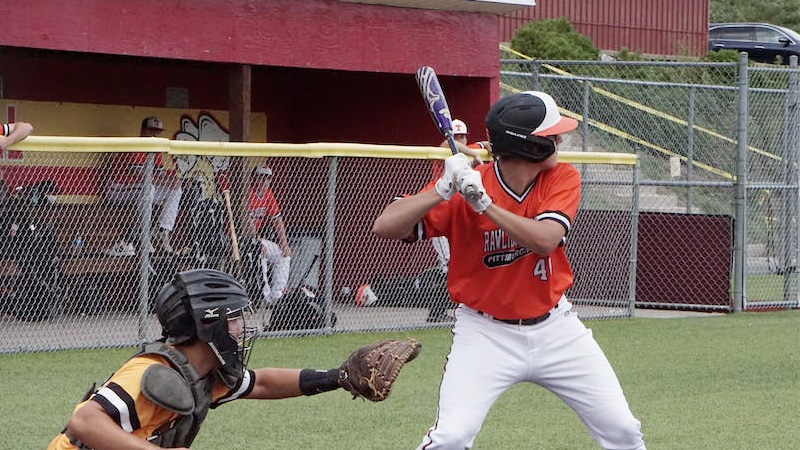Baseball is a sport of intricacies and strategies that go beyond the player’s power and athleticism. While hitting monstrous home runs may captivate fans, there is an art to batting that involves finesse, control, and adaptability.
One such technique that has stood the test of time is known as “choking up” on the bat. Choking up refers to the act of adjusting one’s grip on the bat, sliding it slightly towards the top of the handle.
Whether you’re a player looking to refine your approach or a fan seeking a deeper understanding of the game, join us as we unravel the secrets behind the technique of choking up on the bat in baseball.
What is Choking Up on the Bat in Baseball?
In the game of baseball, batting is a skill that encompasses more than just raw power. It requires finesse, technique, and adaptability. One technique that has been utilized by players for decades is known as “choking up” on the bat.
Choking up involves adjusting the grip on the bat, and sliding it slightly toward the top of the handle. This seemingly minor adjustment can have a significant impact on a batter’s performance at the plate.
This refers to the act of sliding one’s hands closer to the barrel of the bat, away from the bottom of the handle. By doing so, the batter effectively shortens its grip and places more of the bat’s mass closer to the rotation axis.
This adjustment alters the balance of the bat and reduces its rotational inertia. In simpler terms, choking up allows the batter to have more control and maneuverability over the bat during their swing.
Historical Context
Choking up on the bat is not a new concept in baseball. In fact, it has been used by players throughout the history of the sport. Back in the early days of baseball, when power hitting was not as prominent, choking up was a common practice among batters.
Players recognized the need for greater bat control and contact ability, and choking up provided them with an advantage. However, as the game evolved and power-hitting gained more emphasis, the practice of choking up gradually declined.
Today, it is less commonly seen in the big leagues, with many hitters prioritizing power and home runs over other aspects of their game.
Purpose
The primary purpose of choking up on the bat is to enhance a batter’s control and contact ability. By shortening the grip, the batter gains more control over the bat’s movement and can adjust their swing more quickly.
This can be particularly advantageous in situations where making solid contact with the ball is crucial, such as with two strikes or when trying to advance a runner.
Choking up also allows batters to shorten their swing, reducing the risk of strikeouts and increasing the likelihood of putting the ball in play. It is a technique that prioritizes contact and situational hitting over sheer power, providing batters with a strategic advantage on the field.
Mechanics and Technique

Choking up on the bat is more than just adjusting hand positioning. It involves understanding the underlying mechanics and how the technique affects a batter’s swing.
Here, we will explore the various aspects of choking up on the bat, including hand positioning, mass distribution, reduced rotational inertia, and the benefits of a shortened swing.
Hand Positioning
When a batter chokes up on the bat, their hands slide closer to the top of the handle. This adjustment shortens the grip, effectively moving the hands away from the bottom of the handle. By choking up, the batter gains better control and a more precise feel for the bat.
This hand positioning allows for quick adjustments during the swing, providing increased bat control and allowing the batter to react more swiftly to different pitch locations.
Mass Distribution
One of the key effects of choking up on the bat is the redistribution of mass. By sliding the hands up the handle, the bulk of the bat’s mass is brought closer to the rotation axis, which is the player’s hands.
This redistribution alters the balance of the bat, making it feel lighter and easier to maneuver. With more mass concentrated towards the rotation axis, the bat becomes more responsive to the batter’s movements, enabling better control and increased bat speed.
Reduced Rotational Inertia
Choking up on the bat has a direct impact on the rotational inertia of the swing. Rotational inertia refers to the resistance to change in rotational motion. By bringing the mass closer to the rotation axis, the rotational inertia is reduced.
This reduction allows the batter to generate bat speed more quickly, resulting in a faster swing. The decreased rotational inertia enables the batter to react more efficiently to fast pitches and make solid contact with the ball.
Shortened Swing
Choking up on the bat also facilitates a more compact swing. With the hands positioned higher on the handle, the bat’s path to the hitting zone is shortened. This shortened swing offers several advantages.
First, it allows the batter to cover a larger portion of the strike zone, making it easier to make contact with pitches in different locations. Additionally, a shorter swing reduces the time required to complete the swing, increasing the batter’s ability to adjust to different pitch speeds.
The compact swing also decreases the risk of striking out, as it requires less time to execute, giving the batter a better chance to put the ball in play. With the mechanics and technique behind choking up on the bat, players can harness the benefits it offers and incorporate it into their approach at the plate.
Situational Benefits of Choking Up

Choking up on the bat offers several situational benefits that can greatly impact a batter’s performance in specific game scenarios.
Now, we will delve into these benefits, exploring how choking up enhances a batter’s ability to make consistent contact, improve plate discipline with two strikes, excel in situational hitting to advance runners, and execute hit-and-run plays effectively.
Contact and Bat Control
One of the primary advantages of choking up on the bat is the ability to make consistent contact with the ball. By shortening the grip and adjusting hand positioning, batters gain better control over the bat’s movement.
This improved bat control allows them to adjust their swing more precisely, making it easier to make contact with pitches in different locations. Choking up increases the chances of hitting the ball squarely, reducing the likelihood of weakly hit balls or strikeouts.
It is particularly beneficial when facing pitchers with deceptive or overpowering stuff, where making solid contact becomes paramount.
Two-strike Approach
When a batter has two strikes against them, plate discipline and the ability to protect the strike zone become crucial. Choking up on the bat can aid in this regard.
The shortened grip and compact swing associated with choking up enable the batter to cover a larger portion of the strike zone. This broader coverage allows them to better protect against borderline pitches and foul off tough pitches to stay alive.
Choking up promotes a more disciplined approach, helping batters lay off pitches just outside the zone and prolong their at-bats, increasing the chances of reaching base or putting the ball in play.
Advancing Runners
In situations where advancing baserunners is essential, choking up on the bat can prove advantageous. By choking up, batters gain better bat control and reduce the risk of striking out.
This combination of improved contact ability and reduced swing length allows the batter to better execute situational hitting techniques such as bunting, sacrificing, or hitting behind the runner.
Choking up enhances the batter’s ability to make contact with pitches in specific locations, increasing the likelihood of moving the runner or hitting the ball to the desired side of the field.
Hit-and-run Plays
Executing a hit-and-run play requires precise timing and coordination between the batter and the baserunner. Choking up on the bat can enhance the batter’s ability to execute this play effectively.
The shortened grip and compact swing associated with choking up enable the batter to make quick adjustments and put the ball in play with greater control.
Choking up increases bat speed and responsiveness, making it easier for the batter to make contact and direct the ball to a specific area of the field, allowing the baserunner to advance without hesitation.
By utilizing the situational benefits of choking up on the bat, batters can adapt their approach to specific game scenarios, maximizing their chances of success and contributing to the team’s overall offensive strategy.
Modern Trends and Obsolescence
The game of baseball is constantly evolving, and with it, the techniques and approaches used by players. In this section, we will examine the modern trends surrounding choking up on the bat and its potential obsolescence in today’s game.
Power Vs. Contact
In recent years, there has been a noticeable shift in baseball towards a power-centric approach. Home runs and extra-base hits have become highly valued, and players often prioritize maximizing their power potential.
As a result, the practice of choking up on the bat, which is more focused on contact and bat control, has diminished.
Many hitters are willing to sacrifice some contact ability in favor of swinging for the fences, which can reduce the incentive to employ choking up as a regular part of their approach.
Players Who Still Utilize Choking Up
While the usage of choking up on the bat may have declined, there are still players in today’s game who recognize its value and employ it strategically. These players understand the benefits of improved bat control, situational hitting, and making consistent contact.
They have adapted their approach to taking advantage of choking up in specific game situations or when facing challenging pitchers. By doing so, these players demonstrate that the technique still has a place in modern baseball, even if it is not as prevalent as in the past.
Perception and Taboo
The diminishing usage of choking up on the bat in professional baseball has led to a changing perception of the technique. It is now often seen as a less common and somewhat unconventional approach.
Some may view it as a sign of weakness or a lack of power, which contributes to a perceived taboo around choking up. However, it is important to recognize that the technique has its strategic merits and can be a valuable tool in a batter’s arsenal.
The evolving perception and diminishing usage should not overshadow the potential advantages it offers in certain game situations.
Personal Preference and Adaptability
Baseball is a game that values individuality and personal approaches. Each player has their own style, preferences, and strengths. Some players may naturally gravitate towards choking up on the bat, finding it more comfortable or effective for their swing.
Others may prefer a different approach that suits their skills and objectives. The adaptability of players to adjust their approach based on the situation is a crucial aspect of the game.
While choking up may not be as widespread as it once was, players who remain open to different techniques and adapt their approach as needed can still find success.
Modern trends in baseball have shifted towards power-hitting, leading to reduced usage of choking up on the bat. However, there are still players who recognize its value and strategically utilize it in certain game situations.
While it may be perceived as less common or even taboo, the technique should not be dismissed, as it offers advantages in terms of contact, bat control, and situational hitting.
Comparison of Choking Up on the Bat in Baseball
| Aspects | Choking Up on the Bat | Power Hitting Approach |
| Contact Ability | High | Moderate to Low |
| Bat Control | Enhanced | Varies |
| Situational Hitting | Effective | Dependent on power |
| Plate Discipline | Improved | Varies |
| Adaptability | Flexible | Limited |
| Perception in Baseball | Diminishing | Prominent |
FAQs
Is choking up on the bat suitable for all players?
Choking up on the bat is a technique that can be utilized by players of all skill levels. However, its effectiveness may vary depending on the player’s individual style, preferences, and objectives.
Some players may find it more beneficial than others, depending on their swing mechanics and the game situations they frequently encounter.
Does choking up on the bat affect power hitting?
Choking up on the bat is often associated with a focus on contact and bat control rather than power-hitting. By shortening the grip, the overall leverage and potential for power may be reduced.
However, it’s important to note that choking up can still generate respectable power, especially when combined with good swing mechanics and proper technique.
Can choking up on the bat improve a batter’s plate discipline?
Yes, choking up on the bat can contribute to improved plate discipline. By shortening the grip and having better bat control, batters can make adjustments and react more quickly to different pitch locations.
This increased control can enhance their ability to lay off pitches just outside the strike zone and make more selective swings, leading to better plate discipline.
Are there any drawbacks to choking up on the bat?
While choking up on the bat offers advantages in terms of contact and bat control, there can be potential drawbacks. Some batters may find it more challenging to generate power or hit for extra bases when choking up.
Additionally, it may take time for a player to adjust to the altered hand positioning and develop a comfortable feel for the bat. It’s important for players to experiment and find what works best for their individual swing and approach.
Is choking up on the bat only useful in specific game situations?
Choking up on the bat can be beneficial in various game situations, such as with two strikes, advancing runners, or executing hit-and-run plays. However, its usage is not limited to these scenarios.
Some players may choose to choke up regularly as part of their overall approach, while others may employ it selectively based on the pitcher they are facing or the game situation they find themselves in.
Conclusion
Choking up on the bat in baseball is a technique that, while less commonly seen in the modern game, still offers valuable advantages to batters.
While the trend in baseball has shifted towards power-hitting and maximizing home run potential, it is important to recognize the strategic value of choking up on the bat. It remains a viable option for players who prioritize contact, plate discipline, and situational awareness.
Choking up on the bat can provide an advantage in specific game situations and contribute to a well-rounded offensive approach.
As the game of baseball continues to evolve, players and coaches must recognize the benefits of different techniques and adapt their strategies accordingly. While power-hitting may dominate the headlines, the art of choking up on the bat should not be overlooked. Best wishes.







